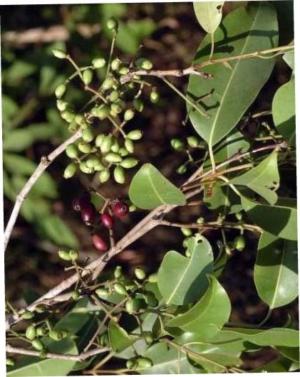Syzygium tenue
(Syzygium tenue)

Description
Syzygium cumini, commonly known as jambolan, Java plum, black plum or jamun, is an evergreen tropical tree in the flowering plant family Myrtaceae. It is native to the Indian Subcontinent, adjoining regions of Southeast Asia, China and Queensland. The name of the fruit is sometimes mistranslated as blackberry, which is a different fruit in an unrelated family. Syzygium cumini has been spread overseas from India by Indian emigrants and at present is common in former tropical British colonies. The tree was introduced to Florida in 1911 by the USDA, and is also now commonly grown in Suriname, Guyana and Trinidad and Tobago. In Brazil, where it was introduced from India during Portuguese colonization, it has dispersed spontaneously in the wild in some places, as its fruits are eagerly sought by various native birds such as thrushes, tanagers and the great kiskadee. This species is considered an invasive in Hawaii. Java plum is also known as Portuguese plum and Malabar plum. Malabar plum may also refer to other species of Syzygium. A slow growing species, it can reach heights of up to 30 m and can live more than 100 years. Its dense foliage provides shade and is grown just for its ornamental value. At the base of the tree, the bark is rough and dark grey, becoming lighter grey and smoother higher up. The wood is water resistant. Because of this it is used in railway sleepers and to install motors in wells. It is sometimes used to make cheap furniture and village dwellings though it is relatively hard to work on. The leaves which have an aroma similar to turpentine, are pinkish when young, changing to a leathery, glossy dark green with a yellow midrib as they mature. The leaves are used as food for livestock, as they have good nutritional value. Syzygium cumini fruit color changing from green to pink to blood red to black as it matures Syzygium cumini trees start flowering from March to April. The flowers are fragrant and small, about 5 mm in diameter. The fruits develop by May or June and resemble large berries; the fruit of Syzygium species is described as "drupaceous". The fruit is oblong, ovoid. Unripe fruit looks green. As it matures, its color changes to pink, then to shining crimson red and finally to black color. A variant of the tree produces white coloured fruit. The fruit has a combination of sweet, mildly sour and astringent flavour and tends to colour the tongue purple. The seed of the fruit is used in various alternative healing systems like Ayurveda Unani and Chinese medicine. Wine and vinegar are also made from the fruit. It has a high source in vitamin A and vitamin C. The 1889 book 'The Useful Native Plants of Australia’ records that the plant was referred to as "Durobbi" by Indigenous Australians, and that "The fruit is much eaten by the natives of India; in appearance it resembles a damson, has a harsh but sweetish flavour, somewhat astringent and acid. It is much eaten by birds, and is a favourite food of the large bat or flying fox.
Taxonomic tree:







